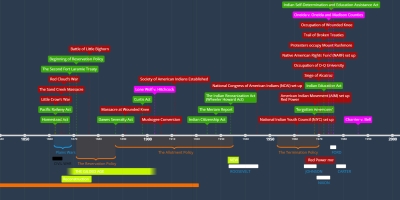jun 25, 1876 - Battle of Little Bighorn
Description:
Crazy Horse and Sitting Bull, leaders of the Sioux tribe on the Great Plains, strongly resisted the efforts of the US government to confine their people to reservations.In 1875, gold had been discovered in the South Dakota Black Hills and the army had ignored previous treaty agreements and invaded the region. This led to many Sioux and Cheyenne tribesmen to leave their reservations and join Crazy Horse and Sitting Bull in Montana. By 1876, more than 10,000 Native Americans had gathered in a camp along the Little Bighorn river in defiance of a US Department order to return to their reservations or risk being attacked.
When the first attack came, a group of 1,200 Native Americans turned back the first wave of soldiers. General Custer's 7th Cavalry were sent in to scout ahead for enemy troops but decided to attack rather than wait for reinforcements - Custer and his 200 men were killed by 3,000 well-armed Native Americans. This was a very rare example of tribal co-operation and active opposition.
The Battle of Little Bighorn marked the most decisive Native American victory and the worst U.S. Army defeat in the long Plains Indian War. The demise of Custer and his men outraged many white Americans and confirmed their image of the Indians as wild and bloodthirsty. Meanwhile, the U.S. government increased its efforts to subdue the tribes. Within five years, almost all of the Sioux and Cheyenne would be confined to reservations.
Added to timeline:
Date:
jun 25, 1876
Now
~ 149 years ago
